- Getting around Lijiang. Dont stay in the Old Towns more than 2 days, there is nothing to do. KRISS Oct 9, 2013 05:46
- 2013 Beijing Temple Fair BENNYLAU Feb 26, 2013 03:29
- Malaysian traveling from KUL - LAX vis Shanghai PVG ZATI_DY Jan 3, 2013 20:15
Hiking Lishan and our Afternoon with Emperor Qin
- Views: 3240
- |Vote: 0 0
- |Add to Favorites
- |Recommend to Friends
Heading Out
On Friday November 18, Tina invited us to venture outside of the city to climb up the famous Lishan mountain...or as Ivy calls it, the Lishan 'hill'. I admit it wasn't the biggest mountain in China, but it was still very high compared to the surrounding countryside. Most of it wasn't overly steep either which was good because we're out of shape and we had to work later in the evening. For the most part, we just wanted to get out of the city, and Tina's offer of seeing Lishan gave us a great opportunity to hang out with her and see a monumental Shaanxi landmark at the same time!
We awoke bright and early Friday morning and met Tina in front of neighbouring electronics market that sits beside our complex. From there we walked to Changle Lu and grabbed a bus to the Train Station to snag an out-of-town coach. I was a little disappointed that morning as the sky was its usual dull, grey self. The thick smog and fog have been choking this city for the past couple of weeks. We were not optimistic to be witnessing any grand vistas atop Lishan, but we did hope for a little clearer skies outside of the downtown Xi'an area. The comfy coach drove east about 30 kilometers on an obviously fairly new highway. The funny thing about this highway was the fact that it appeared off-limits to vehicles! There was almost nothing on the roads! Back in Ontario, this highway would be rumbling with enormous trucks and thousands of commuters transferring into and out of the hub. I don't think commuting really exists here, except for the local farmers who head into the city everyday atop their smoky motortrikes to sell their goods at the fruit and vegetable markets. I assume that the limited number of people who can actually afford a vehicle tend to live in the city as that's where all of the action is. Plus the common idea is to stereotype the country folk as lower class as their living conditions are generallly much worse. This is evident by the people you meet at the market. Not lower class as individuals, but seriously lacking the clean clothes and cool styles that are the aims of the urban population. The division between the rich urbanites and poor country population are more than evident. You can also see it in their teeth! However given the few times we have been outside of Xi'an, the people we have met on our travels have been some of the most interesting. Sure some of them are a little pushing as they are dependent on sales of small goods to tourists, but after a little bargaining, you find them to be very friendly and appreciative of some humour and respect. They're also very curious to find out where we are from. When we tell them 'Women shi Jianadaren. Zai Xi'an, Women shi Yingyu Laoshi' (We are Canadians. We are English teachers in Xi'an), they always respond with a big smile as well as a proclamation that Canada is a wonderful country. Great to hear that our reputation preceeds us! Thank you to all respectable travellers before us. I think our trip here might be a lot more concerning if we suffered from the opposite reputation. It seems though, that the Chinese people are friendly to just about everyone!
Seeking out Chiang
Upon arriving at the foot of Lishan, in the county of Lintong, we winded our way through a few old streets under construction before finding a route to begin our long trek up the hill. The air here was definitely cleaner than the big city, although in smell alone. The fog still reached out far across the landscape and our vision was sadly limited. However that was not going to stop our assent. We started up the steps and began our journey. Luckily there were plenty of little rest stops along the way. Each one owning to a small shop with a keeper selling goods anywhere from cold drinks to large jade sculptures in glass cases. Now what would I do with a jade piece in the middle of a climb up Lishan?? Not sure, therefore I politely passed on those offerings.
Our first interesting section of the hike brought us to the area exhibiting remnants of the world famous Xi'an Incident which climaxed on the slopes of this iconic hill. There were many relics of artillery and vehicles, including an old tank and also a fighter plane. I was shocked to randomly come across such an historic location. If it weren't for a conversation I had had a week earlier with a long-time friend, Jon Patch, regarding the Chinese history he is currently studying at Wilfrid Laurier in Waterloo, Ontario, I wouldn't have known the value of our find. He informed me of the importance of the Xi'an Incident in Chinese political and war-time history during the 20th century. During the early 1930s, the Japanese imperialist invaders had reached far inland and were threatening the infiltration of northwest China. This is an incredible feat if you consider the sheer population size of the civilian population the Japanese were facing. One of the reasons that the Japanese were able to extend their reach so far inland was because of the disappointing state of the Chinese restistance armys. During this time, the ruling Nationalist Party was growing increasingly weaker militarily and politically. Much of its energy was spent fighting off an intensifying civil war between them and the growing Communist Party of China of which Chairman Mao was the founder. The CPC were determined to solidify political control in the country and relentlessly pursued the war with the Nationalists. The Xi'an Incident occurred on December 12, 1936. Growing more and more disappointed in the ongoing civil war and the Nationalist's pathetic fight against the Japanese, two Nationalist Generals Zhang Xueling and Yang Hucheng sent their troops to capture their leader Chiang Kai-Shek who was frightened into hiding out in the Lishan hillside. The generals forced him to make a truce with the Communists and join forces against an aggravating and brutal Japanese enemy. This unexpected coalition between these parties caught the world's attention and helped to coordinate a more effective resistance against the Japanese. It was an interesting thought standing there pondering the history. This was the point that the CPC was welcomed into the political stratosphere by the Nationalists, resulting in its surge in popularity throughout the whole of the country. There was a giant stone carving on the side of the mountain depicting many important events that happened around the time of the Incident. The Chinese are so proud of their Communist accomplishments during this time. Another interesting point for us during this stop was our little climb up a small section of steep rocks. The three of us braved the gravity issue and climbed about 10 meters upwards into a small sheltered crevace. This was the actual place where the Nationalist leader Chiang Kai-Shek was found hiding. It was a great experience, however I didn't truly appreciate the significance of our climb until I did some further research into the Incident a few days later. I always find military and political history fascinating and this place was icing on a cake.
Trees for Thought and a Carving Magician
We continued upwards, making a few stops along the way to enjoy the poor, hazy view of the giant town below. We came across many old pavilions, each of which were painted in many many colours and often included detailed ancient paintings on the ceiling boards. One stop even had a large Bhuddist water fountain overlooking a nearby mountain terrace. It wasn't until after I had snapped a few photos did Tina find me and let me know of the old woman approaching me demanding some money for the privelage of the pictures I took. The lady lived on the mountain in a house built into the side of the hill and this was one of the only ways her family was able to make money. I didn't have a problem paying for some pictures (actually I only paid for one because Tina is a good bargainer!!), although I do notice a trend that people can be quick to ask for money when taking photographs of things they tender to. We walked upwards and by this time we were about half way to the top. The hillside was peaceful and smelled good, although we were very disgusted to see some tunnels and caves in the mountain-side (perhaps built by the fighting Chinese during the 1930s and 40s) that had been reduced to garbage holes. You could see the odd stinking piles if you strained to look as you wandered by. A little extra peak and there it was. I think the park superintendants should be fired for this blunder! We also came across another group of 'stuff' vendors, where Tina took a picture of Andrea and I in front the 'Couples' trees. Here stood two giant trees beside eachother, each aging around 500 years old. It is said in Chinese culture that if you stand here with your spouse you will endure a long happy marriage together. There was even an altar under the trees for you to light an incense stick for Bhudda to bless your marriage. We didn't go that far, we thought we would surely be charged a handfull for that blessing. Continuing onwards a few dozen meters, we ran into a unique artist who was cutting out the silhouettes of a group of girls that were interested in his craft. He was lightning fast and didn't even draw his subjects before starting into the carvings. His work was second-to-none and dirt, dirt cheap. We had to get ones made for ourselves! We have them ready for a frame when we get home and they're even set up to face eachother!
Lintong Blessings from Above
Our next stop came a short distance later as we entered the compound of the Lishan Bhuddist Temple. This find blew me away as both Andrea and I had no idea that this place even existed. Sophie had insisted to Tina to find to this place, but Tina neglected to pass on that information. All for the better though, the surprise was totally worth it! The temple was very large and sat on an outstretched arm of the mountain facing north. The internal courtyards were enclosed by ancient buildings, adding to the overwhelmingness of the place. The temple was built in 762 AD (I'm pretty sure) during the Tang Dynasty, and has been answering the calls of worshippers here ever since. In the first building we purchaced a set of 3 large incense candles that were a blessing for the family. We lit sticks and placed one of them in each of the 3 main halls. I can't remember what each hall was for, but the different Bhudda statues in each hall were for praying the for best wishes of family, health, fortune and good grace. I wouldn't say that I am an a avid Bhuddist follower, but I do highly respect the origins and peacefullness of the faith and therefore I chose to kneel at the feet of each of the statues and offer my prayers. How could I not. It was a strange feeling coming from a traditionally Christian background, but the experience was unique and liberating. I did feel a little extra spiritual that day. Everytime I knelt, and old lady would ring a bell, aparently to call upon the Bhudda to head my prayers. Unfortunately when it came time to choose a fortune slip from an old man in the temple, he imformed me that my final wish may be plagued with obstacles. This scares me considering my final wish was for our adventure in China to be full of great spirit, good health and many friends, all the while staying out of trouble. The girls at school laughed at my plight when I told them about it. They said the fortune was up to me to choose to believe it or not. I did however, ensure my blessings that afternoon by purchasing a blessed Bhuddist necklace on our way out of the temple. I felt as though I needed a little extra help in assuring my wishes came true.
The View from Lishan
From here we headed up the steep steps to the very top of Lishan Mountian. The last 500 meters was by far the most difficult to climb. The cooler air and never-ending staircase forced us to break many times to catch our breaths and soak up the now dwindling view of the temple and landscape below. The top was again lined with a few gift and refreshment shops sitting at the foot of an ancient lookout tower. I believe the tower was also built during the 700s. As was done along the great wall, this tower was one of many in the area that were used to signify any oncoming military threat from the east of the urban areas in and around the ancient city of Xi'an. Lookout guards used to light giant fires in the base of the tower that would rage out the top of the structure, offering advanced warnings to other towers and locations. Although Tina told us that clear days would allow us to see the outskirts of Xi'an itself, the weather prevented us from seeing further than a kilometer or so in any direction. Even the base of the mountain was barely visible to us. After a short rest, we walked back down a little ways before deciding on descending to the bottom via the Lishan cable car. This was a great choice as we were running short on time and the fog began to open up, allowing us fantastic views of the town of Lintong as well as the Emperor's hot springs resort known as the Huaqing Palace Hot Springs. This lies right at the base of Lishan. It is an enormous, beautiful compound that was originally constructed as a garden sanctuary for one of the most famous concubines in Chinese history. Our limited time didn't allow us to tour this place though, we will save the springs for another day. I'll have more valuable information then!
Visiting the Emperor Himself
With just a few hours remaining before Andrea and I had to be back for class, Tina led us onto a bus heading east another 10km to the tomb of the first Emperor, Qin Shi Huang. This was another of our locations that was a must-see for us while we resided in Xi'an, and it didn't disappoint. The tomb is akin to the Valley of the Kings in Egypt. Qin was so revered and so influential during the time of his reign, his subjects built him the most elaborate, ornate and secretive mausoleum complex in all of China. The tomb mound itself lies just slightly to the west of the location where the Terra Cotta Warriors were discovered. The Warriors themselves were actually constructed to be the guardians of this formidable ruler in the afterlife. Also buried around the tomb in varying pits were the original bronze carts, piles of stone-crafted body armour and endless arrays of clay pots and other everyday goods necessary for the afterlife. Qin also requested lifesize clay impersonations of court entertainers and acrobats to be buried alongside him. The actual tomb mound was built in a giant (albeit short) pyramid sitting on the flat countryside, just in front of the Li mountain range. The position and size of the tomb alone recalled to me the great burial sites of the great Kings of Egypt such as Ramses. The inside of Qin's tomb has not yet been opened for numerous reasons. I have described these reasons, as well as the assumed contents that exist inside the tomb, in a previous writing that accounted our travel to the Terra Cotta Warriors in mid-October. The tomb is filled with mysterious for the mind and soul and we will surely jump on the first plane back to Xian if the government ever chooses to open it in the future. We again jump-started our tired legs and the three of us walked up the many steps to the top of the tomb mound. This position gave us an amazing view of the surrounding mountains and countryside. The weather continued to cooperate, much to our happiness. As 2:30 approached, we quickly hurried back down the hill and scored some great seats for a live, open-air show of a mock ceremony offering Emperor Qin a royal introduction. There was loud music, dancing girls, staged battle scenes, food offerings, bamboo scroll readings, and of course, the entrance of the First Emperor himself on a moving chariot, surrounded by his concubines. What a life that guy must have led. The show was a nice glimspe into the world of the past. I got some great pictures and footage on the camera. The crowd was full, as I'm sure it is every day at this time. I got a good laugh when I went into the gift shop after the show. They had on the wall a few pictures of world leaders from the past visiting the site. Of course, thinking I was American, the woman was quick to point out the large picture of President Clinton. I informed her I wasn't interested however, I was much more impressed with the large picture to the right of Clinton which was none other than Jean Chretian, former Prime Minister of Canada!! I never expected to see a photo of him here, hanging on a wall like a big piece of art at such a famous location! I Didn't know he was even here! I asked to get a picture of the picture but surprise surprise they wouldn't let me snap anything without paying some money...it was, after all, a gift shop. Here that means paying out your ears regardless of what you're looking for, even if it is just a picture.
Bargains and Baked Yams
After I rounded up the ladies and snapped a few more pictures (I took around 240 that day!), we strolled out to the side of the road to jump on the next passing bus that was making the trip back into the city. The highway at the tomb entrance was lined with vendors selling all kinds of trinkets. I was flagged down by a little old lady who was selling little cloth handicrafts. I ended up buying a little abstract cat, not because I wanted it, but because I wanted to have a little conversation with her. I think she was a little taken back with my ability to bargain, although now I feel a tad regretful for doing so. She was a kind lady yet I doubt she makes a lot of financial gains sellng small handicrafts. Her appearance was evident of that. I always try to bargain a little as a way of practicing and conversing with the Chinese people, but this was perhaps a time when I shouldn't have. Then again, bargaining is their life and if she was doing business with someone who is Chinese, they likely would have paid a quarter what I paid. And lets be clear, there is always far more Chinese tourists at every famous site, than there is foreigners. I always get a kick out of talking to vendors. When you walk up to a table the first thing they say is either Hello or Welcome. These words usually make up the total English they know. However there are also many vendors who speak English quite well and have learned the language by no other means than simply dealing with foreigners. The vendors on the muslim street downtown speak some of the best English in Xi'an. After a quick Hello, they immediately move on to pick out some random object on their table and insist to you that it is the best buy you could possilby make. Really? Do I really need a Chairman Mao watch?? But the batteries are dead and the watch may not work! No I don't think I need a cheap bronze Terra Cotta statue either to weigh down my luggage! I don't need a compass either!? Perhaps another passer-by would be more obliging to buy whatever you can convince them too! You never know what you'll find at a vendors table! Across the road from the vendors, the opposite shoulder of the highway was lined one after the other with middle-aged women selling fruit. Lintong County produces a wide assortment of fruits and vegetables, but their main claims to fame are Pommegranates (which are big and yellow with dark red seeds inside...delicious and good for your throat) and a strange 'cousin' of a tomato known as a Persimmon. The girls call them sweet tomatoes. They do look a little like tomatoes from the outside, yet they actually grow on trees and have no seeds. The inside looks more like rusty-red coloured mush. Tina bought a small bag to try so I had to go for it. They have a weird taste. It reminded me of eating salad with French dressing on top. It wasn't too bad but I think I'll stick to the pommegranates. Andrea and Tina also bought another snack for the bus ride home, baked yams! Back home this is the last thing you would ever expect to eat as a snack, but here they're everywhere. They're just as famous as hotdog vendors in the cities in Ontario! People sell them out of the big mobile drums where they bake them inside. The hungry buyers simply grab the yam, peel back the outer skin, and munch away! The sight of people eating yams as snacks is still something that blows my mind every time I see it. Now if there is a vegetable that I have never been able to stomach in my past, (besides the obvious and ever-disgusting Parsnip), it has to be yams and sweet potatoes. They make my tastebuds curdle. That's why Andrea didn't bother to buy me one. Still, since we hadn't eaten all day, I was starving and decided that I had to at least try it! So I did. It was incredible!! It was mushy white on the inside and tasted infinitely better than I assumed it would. No wonder people eat them as snacks here (not that its any less odd when they do!) Actually, I think I'll go buy one today for lunch!
So we boarded the bus and headed back to Xi'an It was obvious we were going to be late for work but we didn't mind. We had a wonderful Lishan and Qin adventure. Thank you so much Tina.



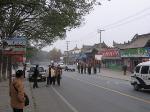

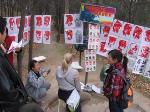
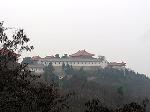
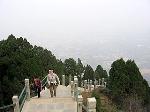
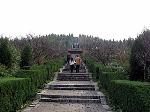

 Copyright © 1998-2025 All rights reserved.
Copyright © 1998-2025 All rights reserved.